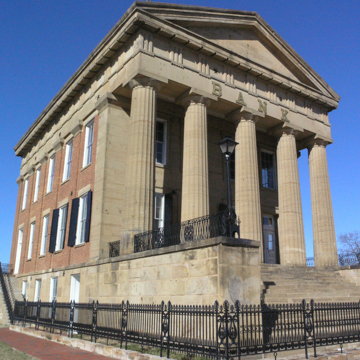You are here
Shawneetown Bank
The Shawneetown Bank was a vital component of a once thriving Ohio River port town. Shawneetown (since 1937, Old Shawneetown) became the federal administrative center (essentially the capitol) of the Northwest Territory in 1798. It was conveniently located on the Ohio River and at the easternmost point of the Goshen Road—a population nexus that ran northwest across central Illinois from Shawneetown to Alton. In addition to the river and road trade, nearby salt mines (and later coal) also generated jobs and money. In 1814 the federal government established its second land office for the Northwest Territory here. The number of immigrants coming to and through Illinois continued to explode, and the population increased over 200 percent between 1810 and 1820 and 350 percent in the following decade. By the late 1830s Shawneetown had become such a vital center of trade that a secure bank became essential. Though a new state bank was chartered in 1835 and, presumably, planning for the bank building began soon after, construction was postponed until after the Panic of 1837.
The origins of the bank’s design are not known, but it seems likely that some of the town’s merchants were familiar with William Strickland’s recently completed and widely published Second National Bank of the United States (1819–1824) in Philadelphia. Strickland’s sober Doric portico set on a stylobate with broad steps became the prototype for banks throughout the country well into the early twentieth century. It conveys dignity, solidity, and was instantly recognizable as a formal place of business. The First National Bank is an accomplished essay in Greek Revival design, suggesting a familiarity with prototypes and/or pattern books, such as those of Minard LaFevre.
In Shawneetown the bank was set on an exceptionally high sandstone basement due to the river’s frequent floods. The monumental sandstone facade has five fluted Doric columns with the unusual fifth column cleverly concealing a secondary entrance. A deep entablature supports the classical pediment. Large double-hung windows with sandstone lintels light the building on three sides. The brick walls of the sides and rear have engaged brick pilasters with sandstone capitols. On the north side, the entablature is replaced with small attic windows. Rear stairs at the southwest corner of the building are supported by a small Doric column. Wrought-iron railings with Greek anthemion designs ornament the parapets flanking the main stairs and the rear stairs. There are no openings of any kind on the rear of the building.
Inside the bank on the primary floor was a large banking hall with an iron vault. A spiral staircase led from a small vestibule to the second-floor offices. Greek Revival mantelpieces and woodwork were used throughout the building.
Although the bank at Shawneetown was built for the ages, time has not been kind to it. Almost as soon as it was completed, Illinois entered a period of economic turmoil and disarray so severe that the state suspended banking operations from 1842 to 1854. The bank reopened but closed again at the start of the Civil War due to the loss of Southern investments. It opened again in 1865 but finally fell victim to massive river flooding in 1937. After the waters in Shawneetown rose two stories high, the town relocated to higher ground inland leaving a ghost town along the riverfront. With the population of southern Illinois already in precipitous decline, now the bank lost its river, its town, and the local market that had supported it. The state of Illinois obtained the bank building in 1942 but it has been closed to the public since then. It stands on Main Street as an empty shell, with no surviving interiors.
References
Farrar, William G., “State Bank,” Gallatin County, Illinois. National Register of Historic Places Inventory–Nomination Form, 1971. National Park Service, U.S. Department of the Interior, Washington, D.C.
Ford, Thomas. History of Illinois, from its Commencement as a State in 1818 to 1847. Chicago: S. C. Griggs and Company, 1854.
Hamlin, Talbot. Greek Revival Architecture in America. New York: Dover, 1964.
Writing Credits
If SAH Archipedia has been useful to you, please consider supporting it.
SAH Archipedia tells the story of the United States through its buildings, landscapes, and cities. This freely available resource empowers the public with authoritative knowledge that deepens their understanding and appreciation of the built environment. But the Society of Architectural Historians, which created SAH Archipedia with University of Virginia Press, needs your support to maintain the high-caliber research, writing, photography, cartography, editing, design, and programming that make SAH Archipedia a trusted online resource available to all who value the history of place, heritage tourism, and learning.













